Glass Flameworking Glass
Introduction to Torchworking Supplies & Tools
By Kristin Arzt
Introduction to Torchworking Supplies & Tools
Introduction to Torchworking Supplies & Tools
Torchworking is a method of heating and shaping glass over a torch to create beads, paperweights, small sculptures, and more. Lampworking is often referred to as torchworking or flameworking depending on the vessel applying heat to the glass. There are a wide variety of torchworking projects, and the tools needed to complete these projects are a very important part of the process.
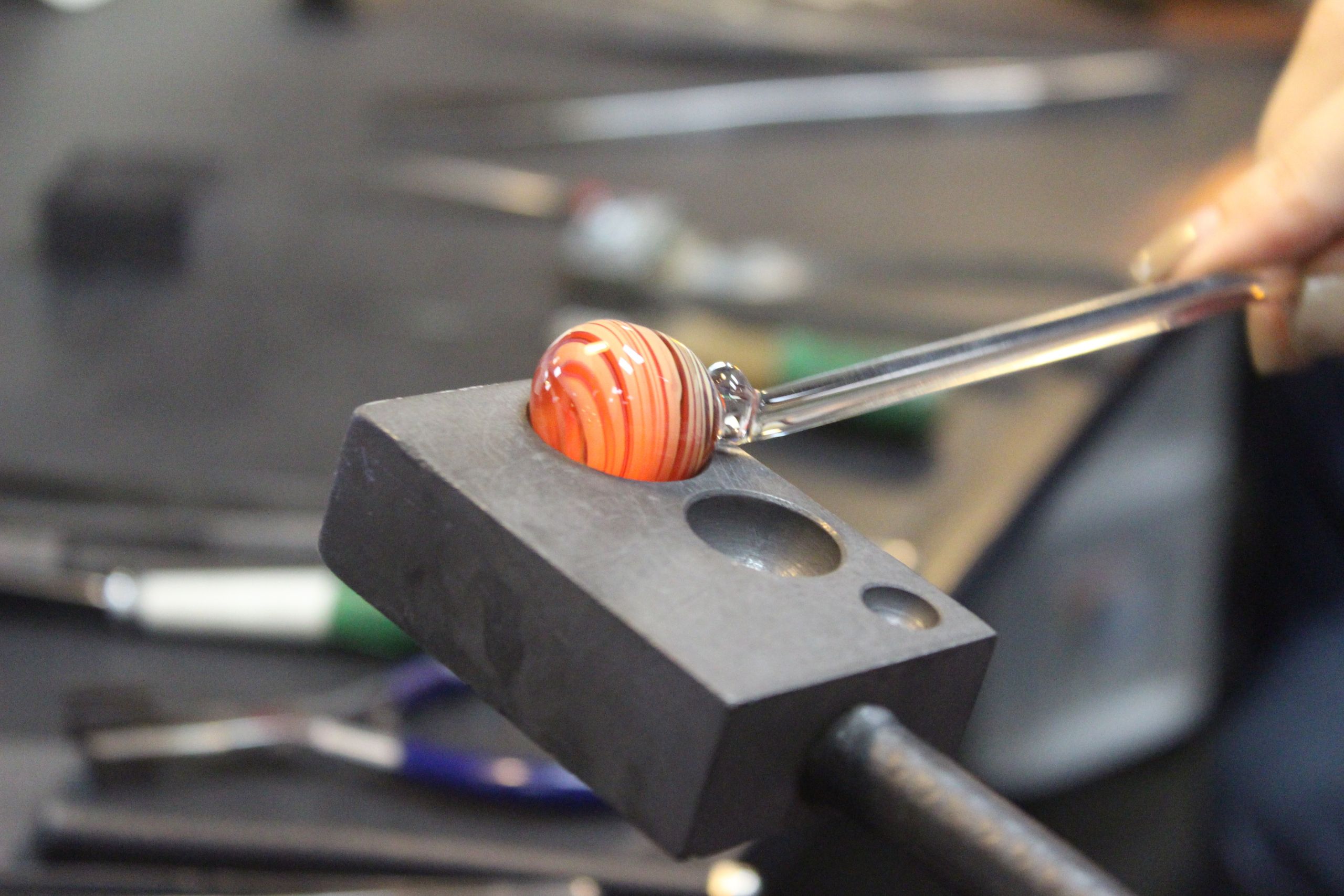
Torchworking safety supplies & protective equipment
As with any hobby—particularly in the industrial arts—torchworking has its hazards. You are more likely to be burned than cut when working with hot glass under a torch, so be sure to have the appropriate lampworking safety gear and a first aid kit (including your favorite burn treatment) in your studio. Always wear natural fibers when working with fire as synthetic fabric will melt onto your skin.
Safety glasses
Protecting your eyes when torchworking is absolutely key. There are a few risks when you begin to work at the torch, such as shattering glass, harmful UV and infrared light, and irritation from sodium flare (also called soda flare). If you decide to work with soft glass, choose a lens that blocks UV light and sodium flare. If you decide to work with borosilicate glass, you will need a lens that offers protection from infrared, UV light, and sodium flare. Wale Apparatus is a great resource for a variety of eyewear options.
Protective gloves
Whether or not to wear gloves is ultimately the choice of the glassworker. The benefit of gloves is that your hands are protected from any heat or potential burns, but some glass workers find gloves can be too bulky to work safely and efficiently. Some prefer thin leather or Kevlar gloves, which can help your hands to avoid direct exposure to the flame. Kevlar sleeves are often used, as this leaves the fingers free for better dexterity, but protects most of the hand and forearm.
A safety tip from the experts
Make sure you check the heat before you pick up a piece of glass. Hold the back of your hand over the top of the glass, as it is more sensitive to heat than the palm. It is important to remember that borosilicate glass stops glowing and looks perfectly innocent at 1000 degrees Fahrenheit. Soft glass expands more than borosilicate, so it is more prone to cracking when in thermal shock, with little bits of hot glass going everywhere! To prevent any unexpected explosions, make sure you introduce your glass to the flame slowly.”–Ralph McCaskey, Glass Flameworking Department Co-Head
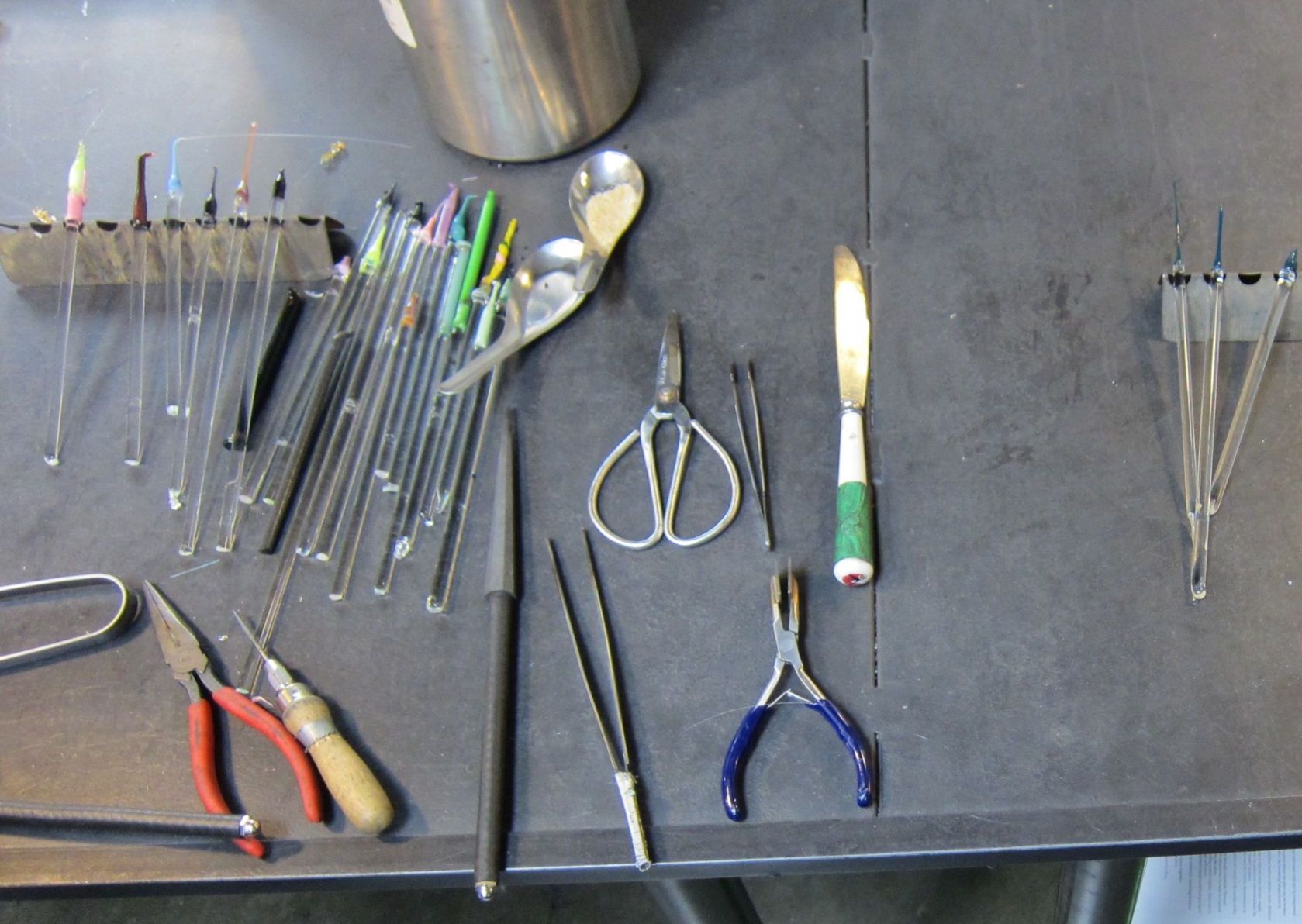
Torchworking materials
There are a few different types of glass used in lampworking, and your project will determine what type of glass you want to use.
Soda-lime glass
Soda-lime glass is the most popular type of glass and also the original formula used in traditional Venetian glass. It is also known as “soft glass.”
Borosilicate glass
Borosilicate glass is a very hard glass that requires greater heat than soft glass. It was discovered by German glassmaker Otto Schott in the late 19th century when heading boron to the soft glass formula. Pyrex is the most commonly used borosilicate glass. The Crucible uses borosilicate glass in the majority of our flameworking classes unless it is clearly indicated that soft glass is being used for sculptural forms. Our favorite to work with is clear Simax borosilicate glass, as it is more affordable and has the same specs as Pyrex and Kimax. For colorful borosilicate glass, we like to source from Glass Alchemy and Northstar.
Torch Fuel
The Crucible’s Glass Flameworking Department uses oxygen-propane torches. Working glass with propane alone takes too long to get up to temperature and can discolor your glass. Adding oxygen to the torch enables you to get the maximum amount of energy out of the propane, and helps balance the chemistry of the flame.
Fiber blanket
Storing your beads in a fiber blanket cools the beads in a controlled environment until you are ready to anneal. It slows down the cooling of the outside of your bead so that the inside and the outside cool at the same rate. Computer-controlled kilns accomplish the same thing, just in a much more controlled way.
Bead-release formula
The first step in glass flameworking when creating something hollow or with a hole is to prepare your mandrel. Dip your mandrel into a release agent so that the molten glass does not fuse directly to the metal mandrel. Release agents are either clay-based or man-made, such as boron nitride.
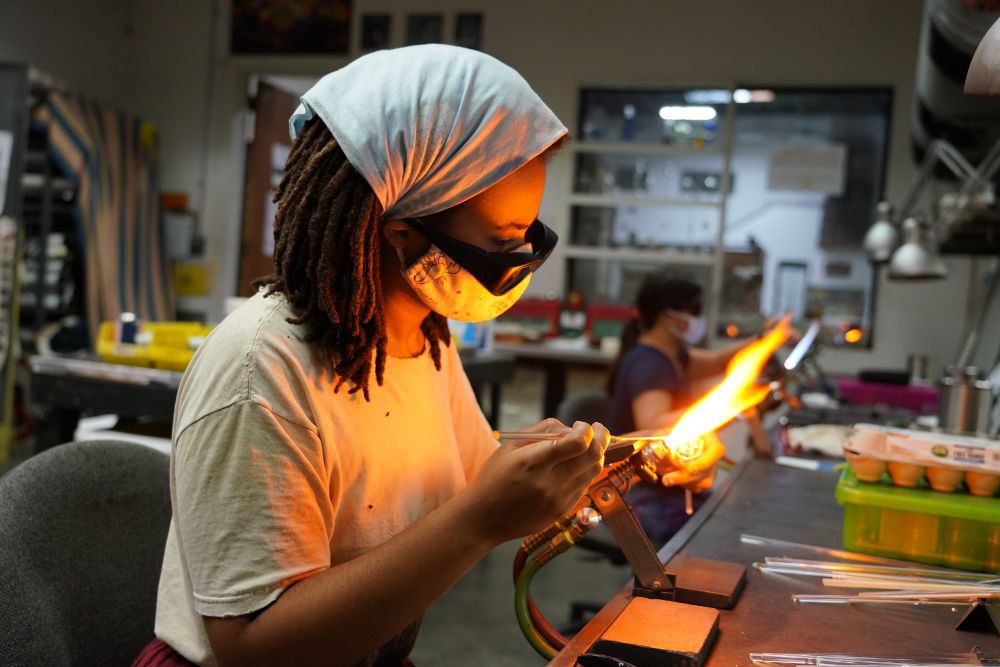
Torchworking supplies and tools
Modern art glass became popular about 60 years ago, and new tools are invented by different artisans every year. There are a variety of tools available designed to help you manipulate hot glass, from essentials like a torch to more aesthetic tools like specialized mashers.
Torch
There are two general types of torches glass lampworkers use surface mix and premix. Surface mix torches are more versatile and keep propane separate from oxygen until both gases have exited the torch. This ensures a quiet, adjustable flame that works well for both soft and borosilicate glasses. A premix torch mixes the propane and oxygen within the torch. Premix torches are generally less expensive, but they only work well with hard glass. They are slightly hotter and noisier.
Annealing kiln
Annealing is the process of slowly cooling down your glass until the piece reaches its “stress relief point” to avoid thermal shock. Once you make your piece, you will need a kiln to anneal it in. The temperature of the kiln will depend on the type of glass. Soft glass is held at 940-970 degrees Fahrenheit and Borosilicate glass is held at 1050 degrees Fahrenheit. The kiln is cooled down at 1 or 2 degrees a minute, so the annealing process generally takes all night. You can find kilns online, our faculty recommend custom, hand-built options available by Arrow Springs.
Marvering pad
Marvering is the process of shaping and cooling the exterior of your hot glass on a heat-resistant surface. Marvering pads are made of steel or graphite. Graphite is very heat resistant, ensuring hot glass will not stick to it. When you purchase a marvering pad through faculty-approved Arrow Springs, they offer a lifetime free tune-up which includes re-sanding the surface to new condition.
Reamer
Reaming knives allow you to make the perfect hole size. They are made of stainless steel and graphite.
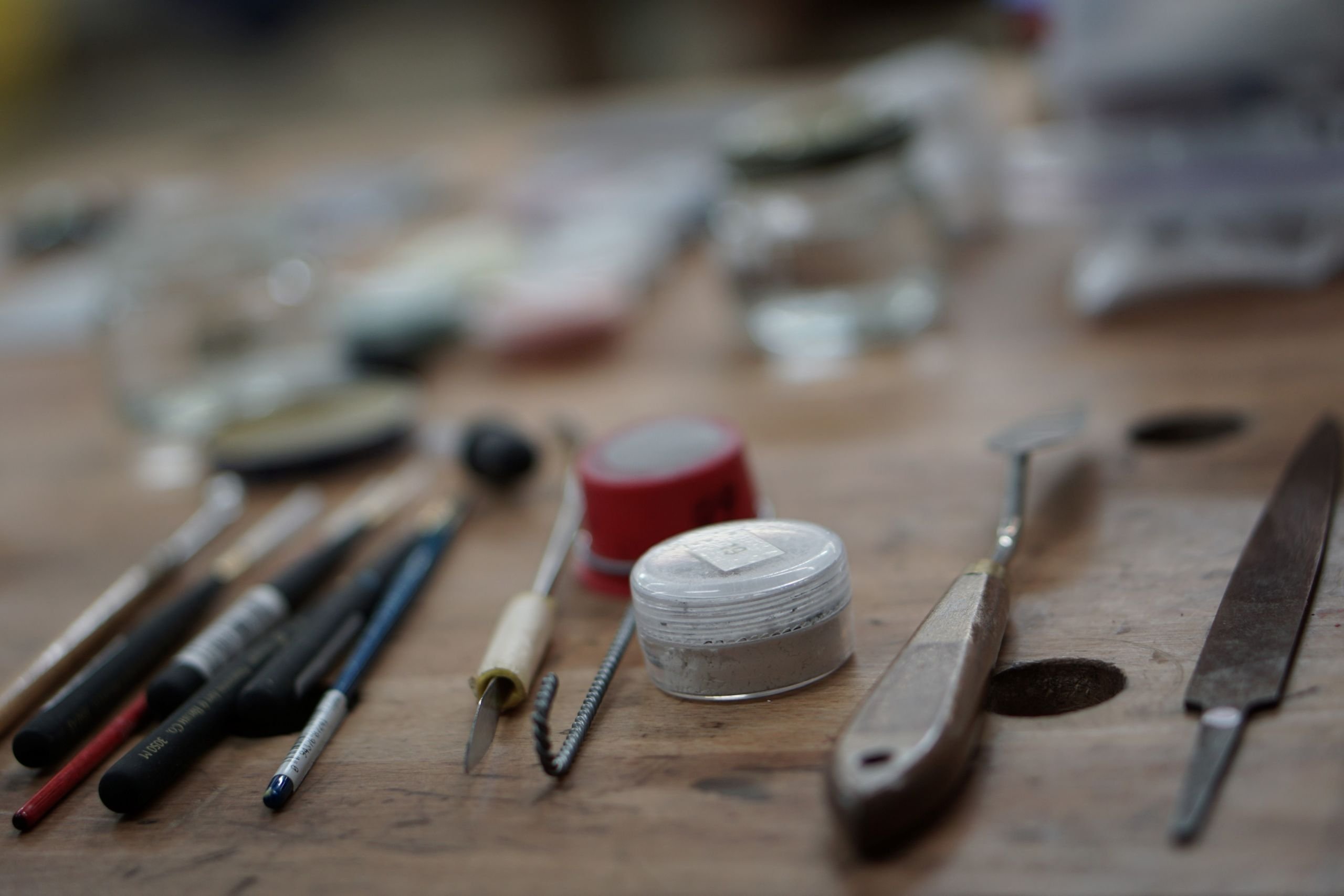
Paddle
Paddles are used for shaping molten glass and are made from stainless steel and graphite. They have handles and are counterweighted for easy control.
Tungsten Pick
Used to poke holes in glass, make bubbles, and more. Tungsten is heat resistant and can be used to make holes in the glass.
Blow hose assembly
A blow hose allows you to blow consistent air inside of the molten glass when forming and create hollow vessels. You may think of it as glass blowing on a smaller scale. A swivel assembly allows you to move your project as you blow into the hose.
Shears
Glass shears enable you to cut through hot glass with scissors. They have a long handle and short blade that give you leverage when cutting. You can use any shears on glass, including those made specifically made for glass, or just regular utility shears found at Harbor Freight.
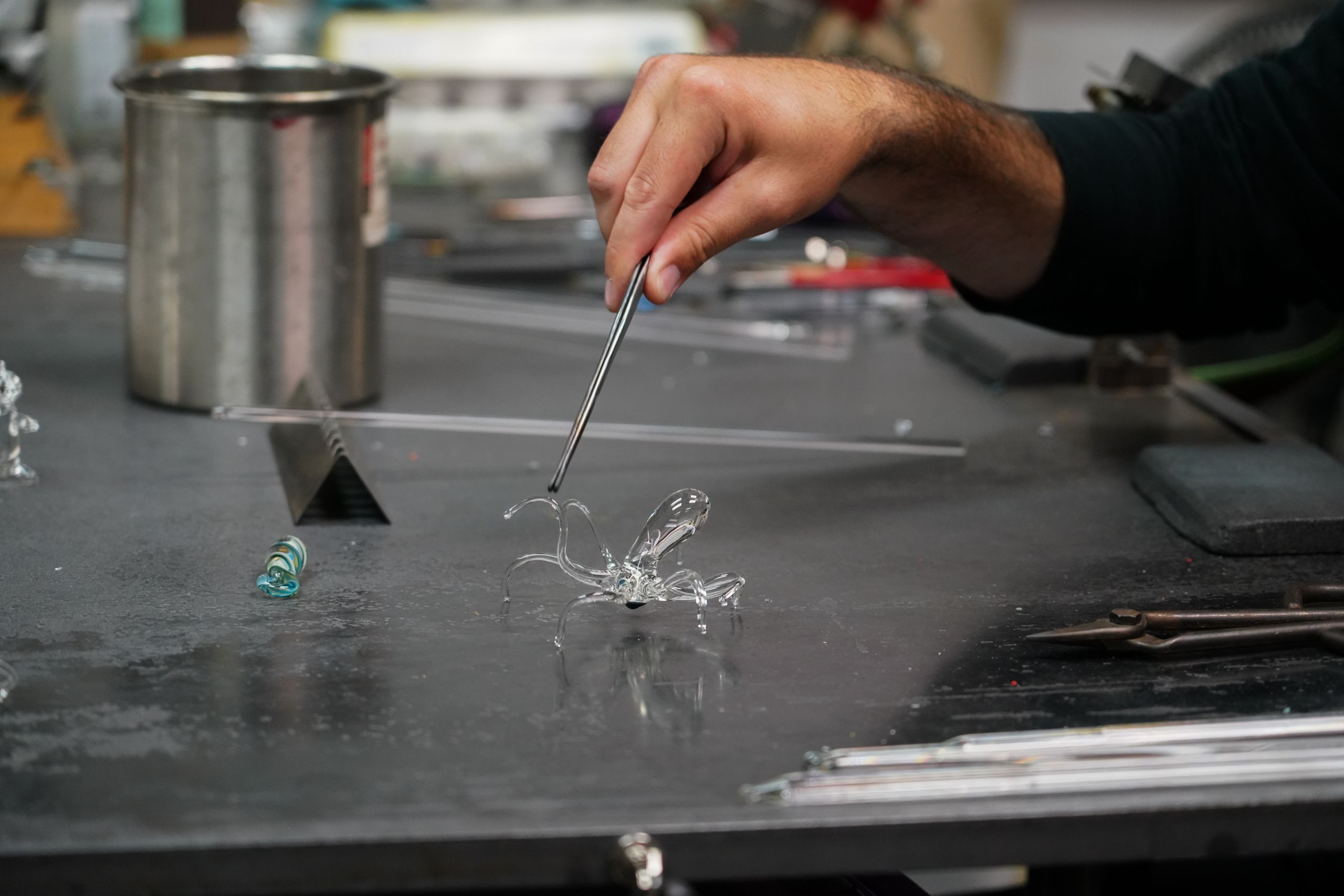
Claw grabbers
Claw grabbers close down on the glass to grasp objects so that you can securely hold and rotate your project as you work it over the flame. Grabbers vary in size and types of metal, so different grabbers will work for different projects.
Lathe
Lathes hold and rotate glass during the glass fabrication process. They come in handy for larger glass projects that may be difficult or tiring to turn by hand. Lathes are most often used for larger hollow projects and scientific work.
Mashers
Mashers are used to press into the hot glass to change the shapes and texture. They come in all shapes and sizes. From large BBQ mashers that get their name from resembling BBQ tongs, to micro mashers that are the size of small postage stamp tweezers, there are different mashers for every project. For practical mashers, visit Arrow Springs. If you are interested in specialized mashers that add texture, check out Carlo Dona.
Mandrel
Mandrels are steel rods that are used to make large holes in glass beads, rings, sculptures, or core formed vessels. Before using your mandrel, dip it in a release agent so that the molten glass does not fuse directly to the metal.
Continue Exploring Guides In Glass
Guide To Enameling: Learn Different Types & Techniques for Enamel Art
Learn the essential common enameling techniques, how to start, and what you create with enameling, from jewelry to bathtubs!...
Glass Casting 101: Process and Techniques
Learn how to create molds and cast your own glass work of art. Get the inside scoop from our Glass Casting & Coldworking Department....
Guide To Vitreous Enamel Vitreous Enamel 101: Definition, Process, & How To Learn
Learn vitreous enameling by fusing glass to metal at high heat, and enamel everything from from precious jewelry to industrial bathtubs!...
Glass Fusing Guide | Fused Glass Explained
Learn exactly what tools and supplies you need to start fusing glass. Get the inside scoop from our Glass Fusing & Slumping Department....
Guide to Glass Slumping: How to Slump Glass in 5 Steps
Learn exactly what tools and supplies you need to start slumping glass. Get the inside scoop from our Glass Fusing & Slumping Department....
Lampworking 101: Guide to Glass Lampworking & Flameworking
Learn exactly what techniques you to learn and how to start lampworking. Get the inside scoop on our Flameworking Department's favorite tips....
You Can Learn To Flamework Glass
The Crucible has new glass lampworking classes offered weekly.
Youth Glass Beads, Bugs, and Monsters!
Students will be taken on a journey to explore colorful glass beads, bugs, and monsters with crazy eyes and wacky facial expressions, using an oxy-propane torch. We will cover bead...
Adventures in Soft Glass: Fabulous Fish
This intermediate-level class will have you sculpting fabulous solid and hollow-bodied fish. Emphasis will be on both structural and delightful decorative glass flameworking...
Adventures In Soft Glass: Finding Your Inner Monster
Extend your glass experience by learning techniques in creating open hollow forms. Monster expert Ralph McCaskey takes you on a journey in soft glass sharing secrets to creating...
Glass Beads I
Learn to make colorful glass beads from Effettre glass rods (a soft glass) using an oxy-propane torch. This class teaches you how to make a variety of bead shapes, introduces tools...
3-Hour Taster: Glass Flameworking
3-Hour Tasters are a great way to explore a new art form without the deeper commitment of a full course. After a basic introduction to melting and shaping borosilicate glass with...
Glass Flameworked Pendant
After a basic introduction to melting and shaping borosilicate glass with an oxy-propane torch, create elegant, organic and beautiful pendants for holiday gifting or for your own...
Glass Hearts
Open your heart to borosilicate glass, while making unique glass hearts in a variety of colors. Using an oxy-propane torch, students will shape glass into pendants and light...
Glass Bead Hearts
Open your heart to soft Italian glass, while making unique glass bead hearts in beautiful colors. Using table top Bravo torch, students will shape glass into heart beads, while...
Advanced Marble Making Techniques
The magical world of glass marble making continues in this course for the enthusiast. Explore advanced techniques, such as color, depth, texture, organic detail, murrine and cane...
Glass Flameworking I
Create beautiful glass ornaments, pendants, marbles, and more! Learn how to use tools and equipment like an oxy-propane torch to melt and shape glass. We will cover a variety of...
Glass Flameworking II
In this intermediate course, we expand on the fundamentals and investigate the intricacies of borosilicate glass flameworking in more involved projects and contemporary designs. In...
Glass Flameworking Lab
Lab sessions are a great benefit, exclusively for Crucible members! Practice the skills you learn in class and explore new possibilities with your craft. No instruction is provided...
Glass Beads II
This intermediate class explores new bead making skills, tools, and materials. Shape beads into hearts, flowers, or animals. Experiment with new techniques, including drawing with...
Glass Flameworking Lab – 1 Day
Lab sessions are a great benefit, exclusively for Crucible members! Practice the skills you learn in class and explore new possibilities with your craft. No instruction is provided...
Glass Sea Shells
Explore the underwater world of sea shells with borosilicate glass. Using an oxy-propane torch, students will sculpt shells in both natural and adventurous color ways....
Coiled Shot Glasses
Learn the traditional ancient Egyptian art of core vessel forming. Building around a core we will duplicate measures used Thousands of years ago to create the first bottles in...
Eggs!
Create Easter Eggs—in glass! After a basic introduction to melting and shaping borosilicate glass, you will complete several egg designs, including the clear gravity marble, the...
Hollow Vessels
Learn to flamework hollow glass, making unique vessels like terrariums, vases, trinket dishes, and spice jars! You will learn proper techniques for shaping and creating a stable...
Youth Soft Glass Beads
Learn to make colorful glass beads from Effettre soft glass rods using an oxy-propane torch. Youth will make a variety of bead shapes, stringers, and twistees and build skill using...
Youth Glass Flameworking II Immersion
Dive deep in this continuing level youth workshop. In this weeklong class, students will expand their skills and techniques for working with borosilicate glass flameworking. Create...
Youth Glass Flameworking I
Create beautiful glass ornaments, pendants, marbles, and more! Learn how to use tools and equipment like an oxy-propane torch to melt and shape glass with confidence. We will cover...
Glass Flameworking Lab (12 hour)
Lab sessions are a great benefit, exclusively for Crucible members! Practice the skills you learn in class and explore new possibilities with your craft. No instruction is provided...
Beginning Marbles
Create nature’s most perfect form—the sphere—in glass! After a basic introduction to melting and shaping borosilicate glass, you will complete several marble designs, including the...
Youth Tiny Wild Things
Students will create colorful glass beads, expressive figurines, and creatures with unique features using an oxy-propane torch and soft glass. We will cover bead surface patterns,...
Glass Flameworked Ornaments
After a refresher on melting and shaping borosilicate glass with an oxy-propane torch, create elegant, icicle-inspired ornaments or miniature candy canes ideal for holiday gifting...































